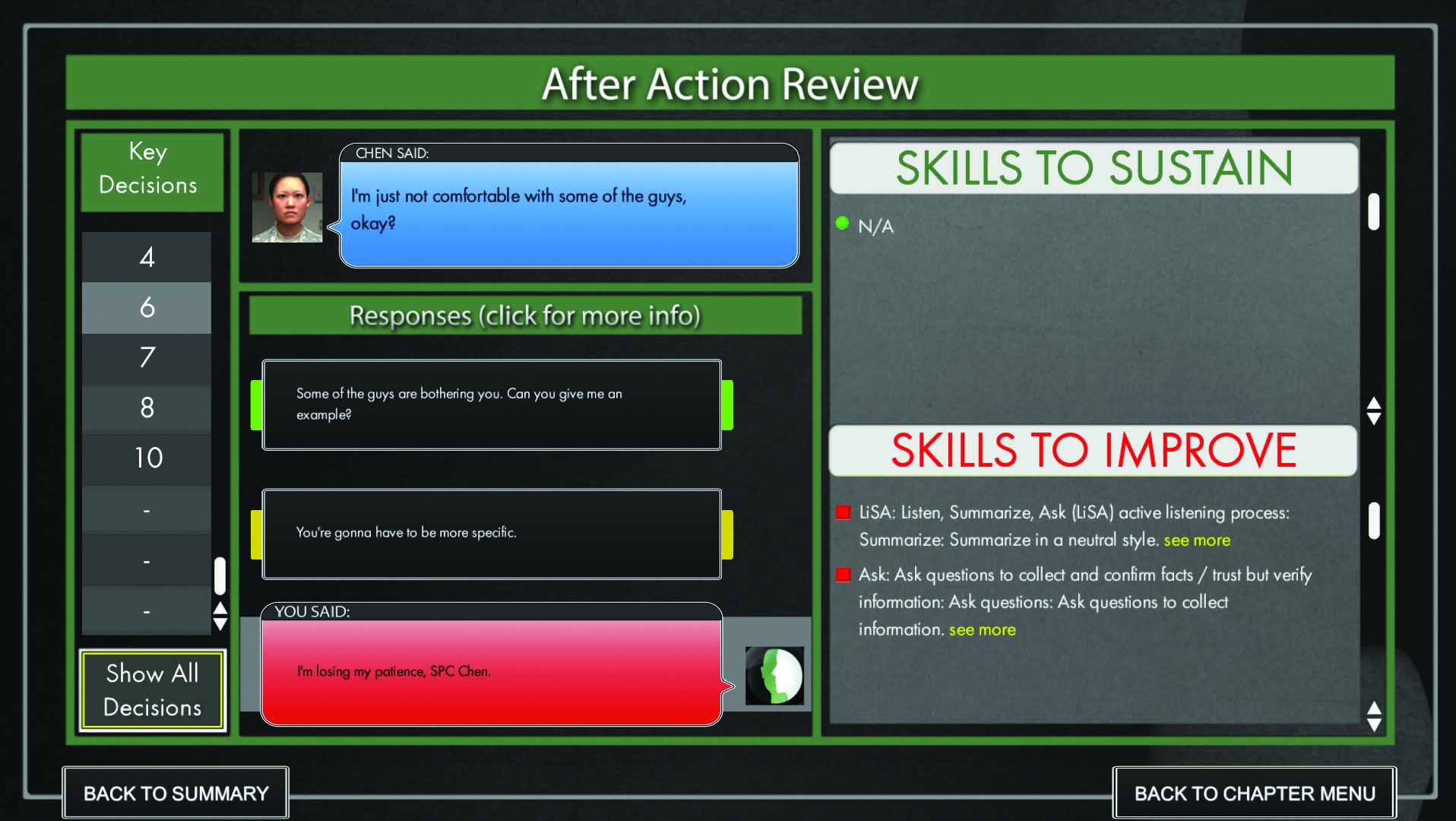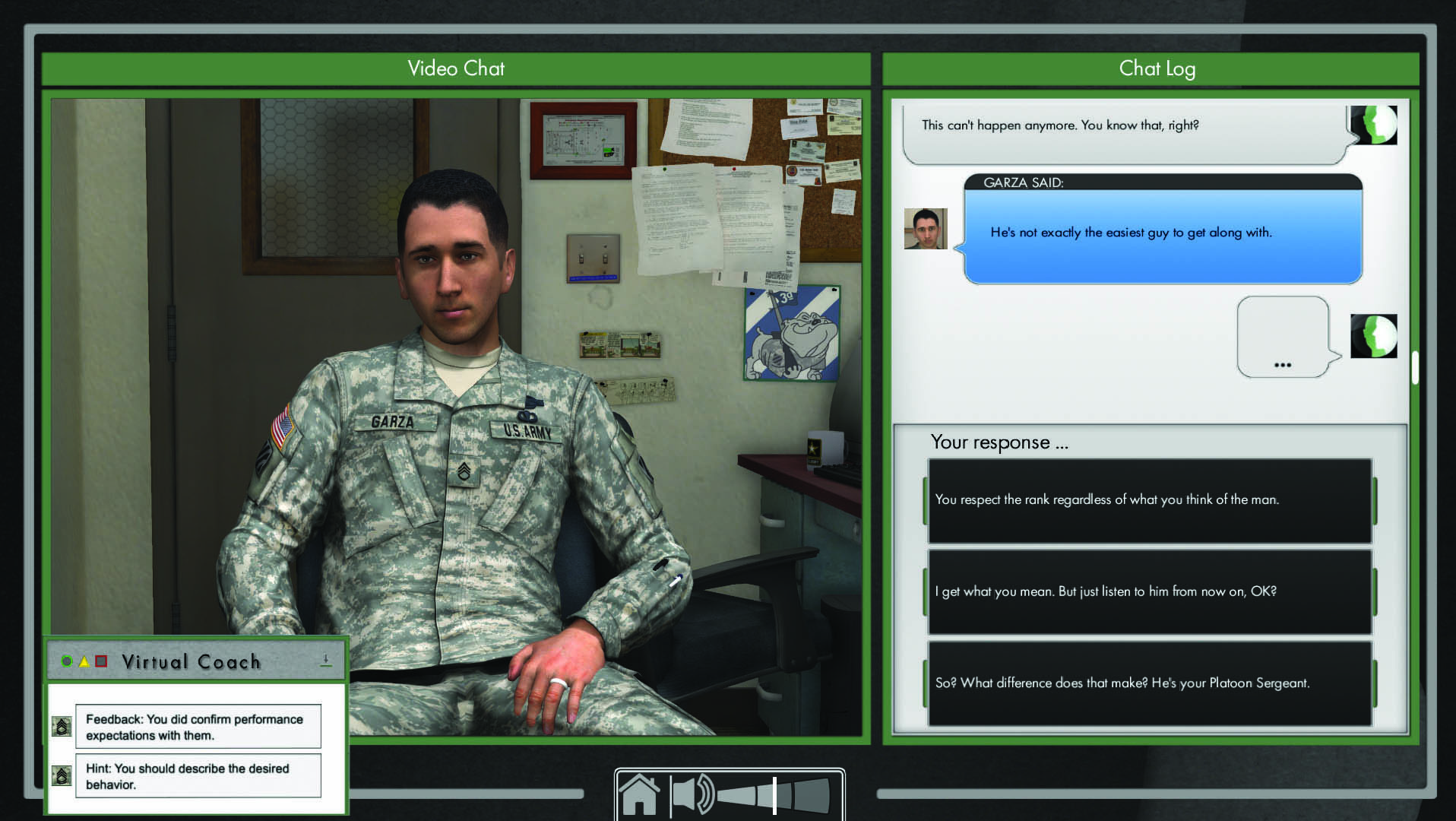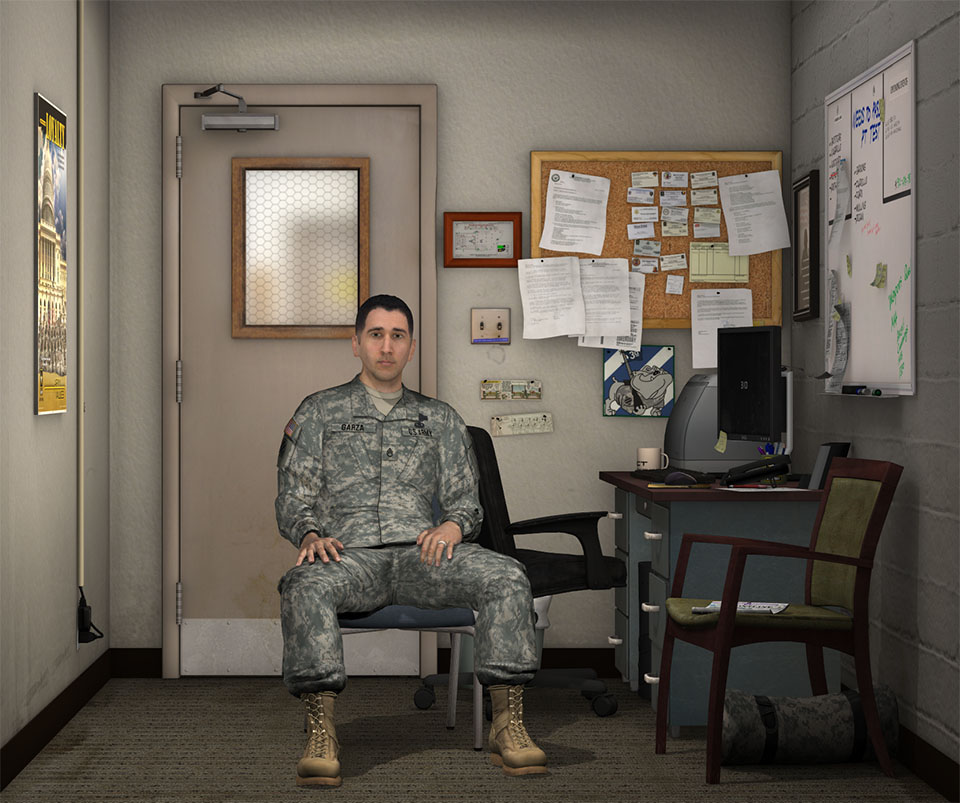
New game-based simulation expands to teach new leaders ‘soft skills’
By Mr. Timothy G. Wansbury, Dr. Randall W. Hill Jr. and Ms. Orli Belman
Effective leaders counsel subordinates for a variety of reasons, from providing feedback for exceptional duty performance to giving guidance to those dealing with personal or work-related problems. Army Field Manual (FM) 6-22 (Army Leadership: Competent, Confident, and Agile) aptly states that counseling is one of the most important leadership development responsibilities for Army leaders.
Traditional training for counseling has relied on a mixture of classroom lectures and discussion, role-playing exercises and hands-on practice filling out counseling forms. However, as early as this fall, the Army will begin changing how it trains junior military leaders to counsel subordinates.
Soldiers will soon be able to learn basic principles of counseling and practice their skills using a laptop-based application called the Emergent Leader Immersive Training Environment (ELITE) Lite. This new training system uses low-cost, game-based “interpersonal communications simulation” in which students conduct interactive counseling sessions with virtual characters in scenarios specifically designed to represent sessions that are challenging for young, inexperienced leaders. These include issues of on-the-job personnel conflicts, financial and family stresses, substance abuse, and other personal difficulties and performance concerns.

VIRTUAL SARGE: Virtual Staff Sgt. Jacob Garza comes to life via laptop in ELITE Lite, an interpersonal skills trainer that will soon be available Armywide as an interpersonal-communication simulation for leader development training. Garza is one in a long line of virtual humans developed at the USC ICT. (Image courtesy of USC ICT)
The ELITE platform represents a new generation of training simulation—one that employs sound instructional design principles along with game technologies to help junior leaders develop “soft” leadership skills like interpersonal communication and counseling. The system employs “virtual human” role-players instead of live actors in engaging practice exercises. It uses artificial intelligence technologies to assess student performance and provides embedded coaching and tutoring as students work through instruction and practice exercises. Much of the research and development (R&D) that produced the ELITE experiences takes place at the University of Southern California Institute for Creative Technologies (USC ICT), a DOD-approved, Army-sponsored, university-affiliated research center.
THE ELITE EXPERIENCE
ICT’s interest in developing the original ELITE system was inspired by the Army Learning Concept (ALC) 2015, which describes the Army’s goal to transform institutional training away from traditional classroom lessons in favor of new dynamic learning environments. Although not focused on any one technology, ALC 2015 envisions using a variety of new virtual environments and game-based technologies to meet the learning needs of future generations of Soldiers.
ELITE provides instruction on key leadership concepts through engaging, interactive classroom instruction and provides the opportunity for students to apply their new knowledge and skills in practice exercises that include performance assessment and feedback in an after-action review (AAR).
ICT has produced two ELITE prototype applications under its Army mission-funded R&D program. The first prototype is a mixed-reality-based solution that was designed for an instructor-facilitated, classroom environment. Mixed-reality environments combine real-world and virtual elements.
In the mixed-reality version of ELITE, a student selected from a group of up to 50 students sits in a room close to the main classroom, called the Digital Immersive Virtual Environment (DIVE). The DIVE looks like a typical work area (office, motor pool, etc.) for a junior leader. The student, in the role of the leader, sits at a desk in this set-designed office space and interacts with a life-sized virtual human subordinate, who appears on a screen in a digital version of the same office.

HOW’D I DO? This screen shot from the ELITE Lite informal counseling trainer, a self-paced, laptop-based tool, depicts an after-action review, which provides students an assessment of their performance and which skills they need to improve. (Image courtesy of USC ICT)
The student leader “speaks” to the virtual character through a microphone, selecting what he or she says from a list of carefully constructed statements. The virtual character has the ability to understand the spoken word and responds to the student in a lifelike, natural manner. The character uses realistic body language, gestures and facial expressions to help make the engagement as realistic as possible. While the student engages with the virtual human in the DIVE, the remaining members of the class can watch the engagement on video screens and participate themselves in the training by using “clickers” to select what they feel are the best leader choices from the same list of statements provided to the student in the DIVE. An instructor-control station captures performance data, including the answers selected by the leader and the classmates following along, to support an instructor-facilitated AAR.
ICT researchers installed the Army’s first mixed-reality ELITE prototype at the U.S. Army Maneuver Center of Excellence (MCoE), Fort Benning, Georgia, in October 2011. Together with MCoE personnel, the researchers conducted a number of training sessions for officers and senior NCOs. SMA Raymond F. Chandler III, having observed an early demonstration of this system in spring 2012, told the Benning Report television news program that counseling was an area of challenge for the Army. “Any tool we have that will make us better at developing our subordinates is in turn going to help us develop a better Army. The ELITE trainer is one of those tools,” Chandler said.
ELITE LITE
The second and newest ELITE prototype is called ELITE Lite, a self-paced, laptop-based version of the original mixed-reality ELITE. It is designed to be used either as a stand-alone, self-paced trainer or as part of an instructor-facilitated classroom exercise.
ELITE Lite offers many of the features of the much larger, mixed-reality version of ELITE. Both systems provide up-front instruction on the basic doctrinal concepts of counseling as outlined in Army FM 6-22, Appendix B (Counseling). Each system includes practice exercises using virtual human characters and artificial intelligence to assess performance and provide coaching, tutoring and feedback during training and in an AAR. Each system has five performance counseling practice scenarios that reflect situations and leadership challenges that many young leaders are likely to experience. The two most recently completed counseling scenarios were developed in partnership with the Army Sexual Harassment/Assault Response and Prevention Program Office.

A LEADER IN HIS FIELD: This screen shot from the ELITE Lite informal counseling trainer depicts an interaction with virtual Staff Sgt. Jacob Garza. An artificial intelligence-based virtual coach offers guidance for students as they navigate the challenges of conducting a performance review in this game-based leader development trainer. (Image courtesy of USC ICT)
While the ELITE mixed-reality version of the training relies on an instructor-facilitated AAR, ELITE Lite concludes with a self-guided AAR. In each case, students receive an overall score for their performance in the practice exercises, and they learn which tasks they did well and which areas need improvement. Future versions of ELITE Lite will provide a network capability that will allow instructors to monitor performance during training and capture it in an instructor station, a capability very similar to what is currently available in the mixed-reality version of the system.
There are however, three big differences between the two versions of the system. ELITE Lite is a laptop-based, virtual human application and therefore has no mixed-reality, DIVE experience. Second, students use a mouse with ELITE Lite to select from a list of text options in order to communicate with the virtual character; they do not use a microphone to speak directly to the character, as with the mixed-reality version. Third, because it is a laptop-based application, the cost to develop and distribute ELITE Lite is a fraction of what it would cost to deploy the mixed-reality solution across the Army.
VIRTUAL HUMANS
Virtual humans are computer-generated characters that use language, have appropriate gestures, show emotion, and react to verbal and nonverbal stimuli. Over the past 15 years, advances in computer graphics and artificial intelligence have allowed researchers to model individual and group behaviors realistically. This has led to significantly enhanced capabilities of simulation, comparable to the capabilities of flight simulators, to support training in the human dimension.
Virtual humans in ELITE Lite provide a cost-effect alternative to the traditional use of human role-players in counseling training. The virtual humans in ELITE Lite can be available 24/7, and there is little or no cost to use or maintain the ELITE Lite system after its fielding. The use of virtual humans in ELITE Lite provides an opportunity to introduce diversity—of gender, race, age and cultural background—among the various role-players in the practice exercises, whereas achieving the same degree of diversity with live actors would be difficult while providing training across the Army. Virtual humans also provide a much-needed, standard and consistent training experience with which to assess interactions across the entire Army.

COUNSELING CENTER: ELITE Lite teaches interpersonal skills to Army junior leaders by presenting real-world instructional scenarios in an engaging, self-reinforcing manner. The purpose of the training experience is to give junior leaders an opportunity to learn, practice and assess interpersonal communication skills for use in basic counseling. (Image courtesy of USC ICT)
AN ARMYWIDE TOOL
ICT completed the first version of ELITE Lite in June and is working with the U.S. Army Research Laboratory (ARL) to transition the application to the Army’s Program Executive Office for Simulation, Training and Instrumentation (PEO STRI) and the Army Games for Training Program. The U.S. Army Combined Arms Center recently finalized the accreditation of ELITE Lite, and PEO STRI has obtained an approved certificate of networthiness, thereby permitting users to install the ELITE Lite software on Army networked computers. The Games for Training Program will soon begin to distribute the ELITE Lite software Armywide via the Army MilGaming Portal.
The Department of Behavioral Sciences and Leadership at the United States Military Academy (USMA) at West Point has amended the curriculum for PL300: Military Leadership to include a block of instruction on counseling. This academic course for all third-year cadets is an integral part of each cadet’s leader development training.
The department has chosen to use ELITE Lite to aid in cadet learning. Starting with the 2014-15 academic year, approximately 600 cadets per semester (1,200 per year) will use ELITE Lite as a supplement to the classroom instruction. The U.S. Army Sergeants Major Academy is also investigating the use of ELITE Lite in the Warrior Leader Course.
The Army recently approved a new set of requirements for a follow-on, enhanced counseling skills trainer. The new solution, called ELITE Pro, will require an expansion of the ELITE Lite platform to include a new networked capability with enhanced instructor assessment and feedback. ELITE Pro will also contain a new set of scenario authoring tools, which will support the rapid development of new scenarios and training content.

MIXED-REALITY MAN: Virtual Staff Sgt. Jacob Garza is part of the ICT’s mixed-reality ELITE prototype installed at MCoE in October 2011. ELITE Lite, by comparison, is a laptop-based application whereby students use a mouse to select from a list of text options to communicate with the virtual character. By providing a portable version of the full mixed-reality prototype, ELITE Lite costs a lot less to develop and can now be distributed across the Army via the MilGaming Portal. (Image courtesy of USC ICT)
CONCLUSION
ICT’s long-term vision is to expand the capabilities of the ELITE platform to allow for its use in satisfying additional leadership development training requirements in the future. The institute is also exploring new opportunities for using virtual humans to improve training, education and health care.
In addition to delivering a new method for training young Army leaders, the ELITE project demonstrates how key stakeholders representing Army combat developers, materiel developers, researchers within the R&D community (both government and academia), and content subject-matter experts can work together to design, develop, transition and field an effective training solution for the Army.
For more information, go to www.ict.usc.edu.
MR. TIMOTHY G. WANSBURY is a technology transition officer with the Simulation and Training Technology Center of ARL’s Human Research and Engineering Directorate. A retired Army colonel with 25 years of service as a finance corps officer and comptroller, he holds an M.S. in business administration from the Army Comptrollership Course at Syracuse University and a B.S. from the University of Vermont, and is a graduate of the U.S. Army War College.
DR. RANDALL W. HILL JR. is executive director of USC ICT. He holds a Ph.D. and M.S. in computer science from USC, and a B.S. from USMA. He served for six years as a commissioned officer in the Army, with assignments in field artillery and military intelligence. He is a member of the Association for the Advancement of Artificial Intelligence and serves on the Board on Army Science and Technology of the National Academies.
MS. ORLI BELMAN is the public relations and projects manager at ICT. She has an M.S. in journalism from Columbia University and a B.A. in East Asian studies from the University of California, Los Angeles.
This article was originally published in the October – December 2014 issue of Army AL&T magazine.
Subscribe to Access AL&T is the premier online news source for the Acquisition, Logistics, and Technology (AL&T) Workforce.
![]() Subscribe
Subscribe







